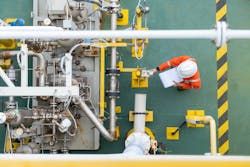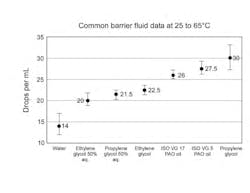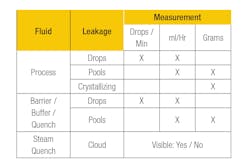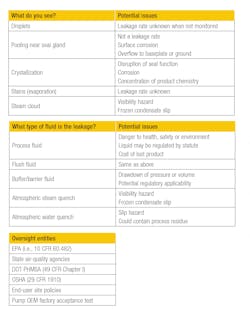Quantifying and assessing liquid leakage from shaft seals
Seal leakage — and its changes that occur over time — can provide reliability personnel with significant information about the entire pumping system. Some may focus only on whether seal leakage meets environmental limits placed by federal and state regulators. And, while reducing or maintaining emission levels is important, focusing solely on this aspect of seal leakage ignores a powerful tool for assessing equipment health.
Mechanical seal leakage can involve either the process fluid itself or some external sealing fluid. As a result, one must consider whether this poses a risk to the health and safety of plant personnel, the environment, the life span of the equipment or site cleanliness policies when evaluating different measurement options.
Quantifying leakage
There are multiple methods for quantifying mechanical seal leakage. Common units of measure for leakage are drops per minute (dpm), milliliters per hour (ml/hr, same as cc/hr) and ounces per hour (oz/hr). One milliliter is equal to 1 cubic centimeter. If the fluid crystallizes, the recommended unit of measure is grams per day (g/d).
At times, the leakage rate itself is unknown, but accumulated leakage is visible. For example, this occurs when a pool forms around the equipment or a stain appears, but the seal is not actively leaking at the time of inspection. Common units for pooled leakage are grams or milliliters. The suggested units of measure for a stain are square centimeters or square inches.
The surface tension of a liquid governs the droplet volume and pooling characteristics. It is an intrinsic property (or “look-up” value) that is a result of the intermolecular cohesive forces. Liquids with very strong intermolecular cohesion, such as water, have high surface tensions compared to those with weak cohesion, such as oils. A high surface tension allows a much larger droplet to form. Higher adhesion of a liquid to another surface creates a flatter droplet. Unfortunately, there is no direct conversion from surface tension to droplet volume. This is because the size of the droplet can also be controlled by the geometry of the dispensing tip, the temperature of the liquid and impurities that are present.
Figure 1 shows data that the authors recorded over a typical drip temperature range and a dispensing tip similar to small-diameter tubing.
Higher surface-tension liquids appear to leak less than those with a lower surface tension, but this is not the case. Higher surface-tension liquids adhere to multiple surfaces within a seal prior to dripping from a weep hole or overflowing to a drain connection. Lower surface-tension liquids exit a seal almost immediately due to the pull of gravity. As such, the same seal design in two separate applications may begin visibly leaking at two separate points. This is important for assessing when the leakage began.
Assessing leakage
After measuring the leakage rate and accumulation, what can be done with this information?
It is best to evaluate a leakage trend over time. Does the rate remain consistent? Is it steadily increasing? Or are there sudden spikes? The answers to these questions provide more insight into the performance of the seal.
The authors recommend obtaining a baseline of the leakage rate and accumulation when starting a new piece of equipment or seal design. Storing this piece of information along with subsequent leakage measurements in a facility’s asset management software allows maintenance and reliability personnel to review trends and discuss the health of the equipment with OEM representatives. Some asset management software can provide warnings when measured leakage exceeds a threshold set by the user.
This data allows maintenance and reliability practitioners to evaluate the risk that the leakage poses to equipment, the environment and operations personnel. A timely review of leakage rates and accumulation allows users to schedule repairs and avoid equipment damage or catastrophic failures.
In certain applications, federal, state or site guidelines require the reporting or recording of a measured leakage rate and quantity. Similarly, these organizations may dictate the proper disposal procedure for a sample of leakage. It is important to be responsible when disposing of leakage. Dumping a liquid down a drain or sewer or placing a crystallized solid in a trash can is unacceptable. Health, safety and environmental rules may require clearing the baseplate or ground of any uncaptured external leakage as well.
The risks from exposure to process leakage include both acute and chronic health issues. This is true for both chemical and water services (see Table 2). In the case of wastewater, harmful bacteria are present prior to filtration and treatment. Heavy metals and radioactive material may be present in water removed from mining operations. Oil or chemical leakage is also a safety concern. Synthetic oils and glycols are slip hazards for operations personnel. Over time, corrosive process fluids may attack and weaken nearby structures.
The protection of plants, insects and wildlife is an aspect of environmental regulation. Both process and flush-fluid leakage can harm living organisms. For example, glycols can attract harmful insects and can be deadly if ingested by animals. Without proper remediation, external leakage can seep into the ground. These risks must be taken into consideration when determining where and how to route external seal leakage.
John Merrill is a principal engineer with EagleBurgmann and resides in Charlotte, North Carolina. He has worked in the seal industry since 1990. Merrill received a Bachelor of Science in mechanical engineering from the University of Tulsa and a Master of Science from Western Michigan University. He is an active participant in the Hydraulic Institute, API 682 and ASM International.
Gabriel Young is a senior engineer with EagleBurgmann in Denver, Colorado. He received his Bachelor of Science in mechanical engineering from St. Louis University and has worked in the seal industry since 2012. Young is an active participant in the Hydraulic Institute.
Gabriel Young
Gabriel Young is a senior engineer with EagleBurgmann in Denver, Colorado. He received his Bachelor of Science in mechanical engineering from St. Louis University and has worked in the seal industry since 2012. Young is an active participant in the Hydraulic Institute.
John Merrill
John Merrill is a principal engineer with EagleBurgmann and resides in Charlotte, North Carolina. He has worked in the seal industry since 1990. Merrill received a Bachelor of Science in mechanical engineering from the University of Tulsa and a Master of Science from Western Michigan University. He is an active participant in the Hydraulic Institute, API 682, and ASM International.





